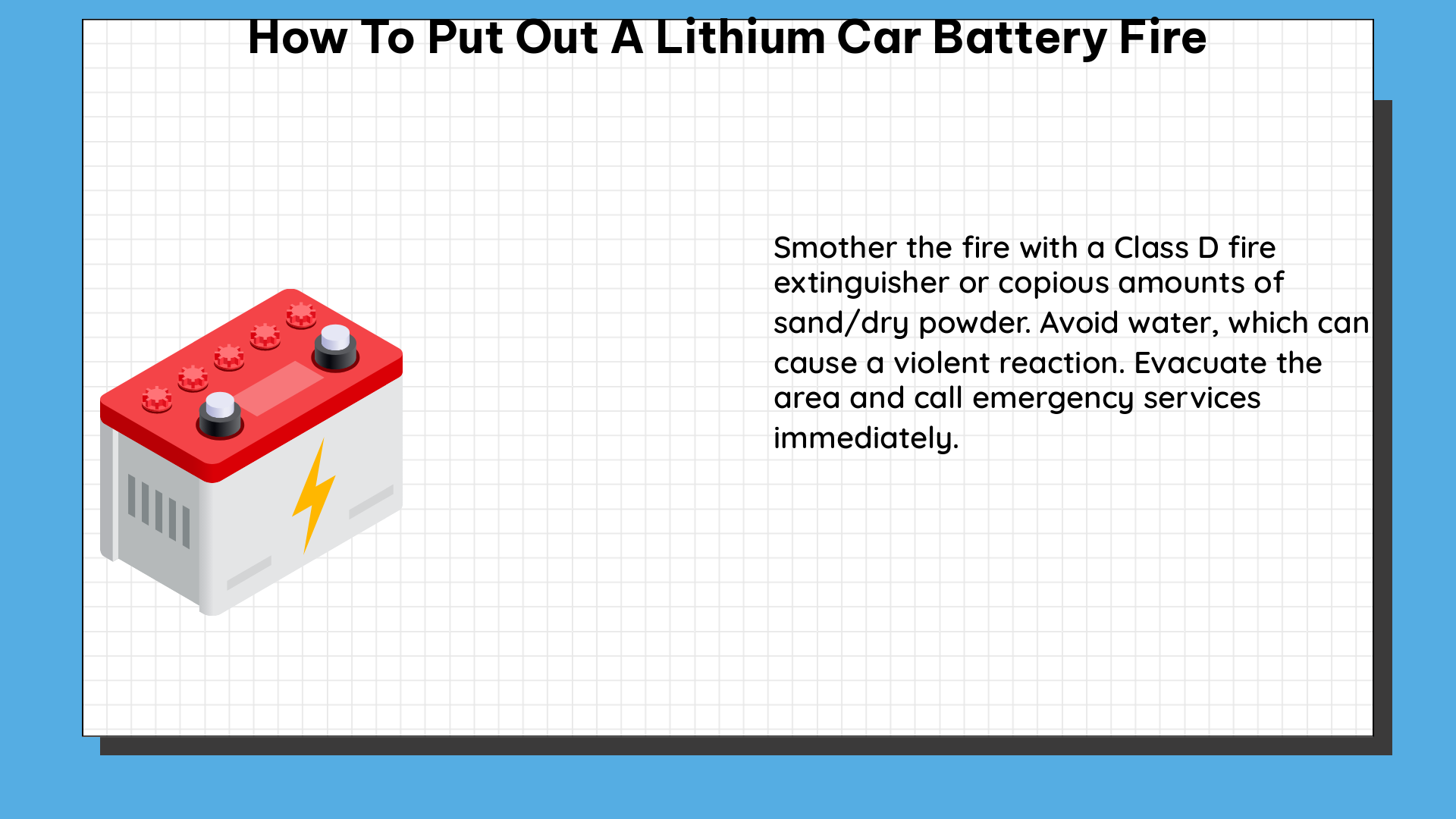Lithium-ion batteries power many of our modern devices, including electric vehicles. However, these batteries can pose a significant fire risk if not handled properly. In the event of a lithium car battery fire, it is crucial to understand the specific steps required to extinguish the blaze safely and effectively. This comprehensive guide will provide you with the technical details and expert-level insights to handle a lithium car battery fire.
Understanding Lithium-Ion Battery Fires
Lithium-ion battery fires are classified into three distinct categories: Class A, Class B, and Class C. Each class requires a unique extinguishing approach due to the varying nature of the fire.
Class A Fires
Class A fires involve ordinary combustible materials, such as paper, wood, or cloth. These fires can be extinguished using water, foam, or dry chemical agents.
Class B Fires
Class B fires involve flammable liquids, such as gasoline, oil, or alcohol. These fires require the use of foam or dry chemical agents, as water can spread the fire.
Class C Fires
Class C fires involve energized electrical equipment, such as the lithium-ion battery in an electric vehicle. These fires require the use of non-conductive extinguishing agents, such as carbon dioxide (CO2) or dry chemical agents.
Lithium-ion battery fires occur due to a phenomenon known as “thermal runaway.” This happens when the battery cells become overheated, leading to the release of flammable, explosive, and toxic off-gases. The overheating can be caused by electrical short circuits, rapid charging, discharging cycles, or manufacturing defects.
Extinguishing a Lithium Car Battery Fire

When dealing with a lithium-ion battery fire in a car, the first and most crucial step is to evacuate the immediate area and alert the local fire department. These fires can be unpredictable and escalate rapidly, posing a significant risk of explosion and the release of hazardous materials.
Specialized Extinguishing Agents
The recommended extinguishing agent for lithium-ion battery fires is the F-500 Encapsulator Agent. This agent is specifically designed to address the unique challenges of these fires, including flammability, explosivity, and toxicity.
The F-500 Encapsulator Agent can be premixed and proportioned at a 3% solution for effective fire mitigation. This agent works by:
- Encapsulating the burning lithium-ion battery cells, preventing the spread of the fire.
- Cooling the battery cells, reducing the risk of thermal runaway.
- Neutralizing the toxic off-gases released during the fire.
In addition to the F-500 Encapsulator Agent, other specialized extinguishing agents, such as Purple K (potassium bicarbonate) or Copper Powder, may also be effective in extinguishing lithium-ion battery fires.
Extinguishing Procedure
The recommended extinguishing procedure for a lithium car battery fire is as follows:
- Evacuate the immediate area and alert the local fire department.
- If safe to do so, attempt to isolate the burning battery pack from the rest of the vehicle.
- Apply the F-500 Encapsulator Agent or other specialized extinguishing agent directly onto the burning battery pack, using a suitable fire extinguisher or foam applicator.
- Continuously apply the extinguishing agent until the fire is completely extinguished and the battery pack has cooled down.
- Avoid using water, as it can spread the fire and react with the burning lithium-ion cells, potentially causing an explosion.
- Ensure that the extinguished battery pack is properly disposed of by a qualified hazardous waste management service.
Preventative Measures
In addition to understanding how to extinguish a lithium-ion battery fire, it is essential to take preventative measures to minimize the risk of such incidents occurring in the first place. These measures include:
- Purchasing batteries from reputable manufacturers with a proven track record of safety and quality.
- Never attempting to recharge non-rechargeable batteries.
- Disconnecting batteries from chargers once the charging cycle is complete.
- Using only chargers approved by the battery manufacturer.
- Keeping batteries away from extreme temperatures, both hot and cold.
- Charging batteries in a fire-safe charging bag or container.
- Regularly inspecting batteries for signs of damage, such as swelling, leakage, or physical deformation.
By following these preventative measures and being prepared to respond effectively to a lithium car battery fire, you can help ensure the safety of yourself and those around you.
Conclusion
Lithium-ion battery fires pose a unique challenge due to their potential for rapid escalation, flammability, explosivity, and toxicity. By understanding the different fire classes, using specialized extinguishing agents, and implementing preventative measures, you can be better equipped to handle a lithium car battery fire safely and effectively. Remember, the key to mitigating these types of fires is swift action, the right equipment, and a thorough understanding of the underlying risks.
References:
- How Do You Put Out a Lithium-Ion Battery Fire?
- How Do You Extinguish a Lithium Battery Fire?
- How to Put Out a Lithium-Ion Battery Fire
- Lithium-Ion Battery Fire Extinguishing Agents
- Lithium-Ion Battery Fire Safety

The lambdageeks.com Core SME Team is a group of experienced subject matter experts from diverse scientific and technical fields including Physics, Chemistry, Technology,Electronics & Electrical Engineering, Automotive, Mechanical Engineering. Our team collaborates to create high-quality, well-researched articles on a wide range of science and technology topics for the lambdageeks.com website.
All Our Senior SME are having more than 7 Years of experience in the respective fields . They are either Working Industry Professionals or assocaited With different Universities. Refer Our Authors Page to get to know About our Core SMEs.